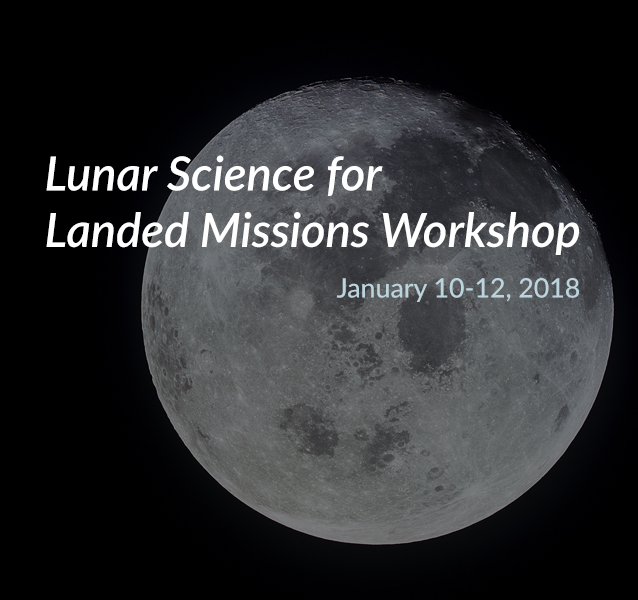SSERVI Publications
Visit the SSERVI Publication Database
NLSI Publications
NASA Science Strategy at the Moon
STMD Strategic Framework for PRISM
White Papers
Value of Virtual Institutes & the Synergy of Science and Exploration
Virtual Institutes are a powerful tool to address complex, multidisciplinary problems of high agency priority. With SSERVI, NASA has engaged multifaceted research teams which bridge planetary science, astrophysics, heliophysics, and human exploration, to provide a flexible, international platform for addressing key agency programs, such as Artemis.
(SSERVI) Decadal Survey in Planetary Sciences and Astrobiology Whitepaper, 2020Lunar Polar Volatiles: Assessment of Existing Observations for Exploration
(Dana Hurley) White Paper on water ice and other lunar volatiles, 2016Heliophysics Science by the NLSI LUNAR Team: Solar Radio Astronomy, Particle Acceleration, & Interplanetary Dust
(Jack Burns) LUNAR White Paper on Radioheliophysics, 2012Astrophysics Conducted by the Lunar University Network for Astrophysics (LUNAR) and the Center for Lunar Origins and Evolution (CLOE)
(Jack Burns/Bill Bottke) The LUNAR and CLOE Consortium White Paper on Astrophysics, 2012Exploring the Bombardment History of the Moon
(Bill Bottke) Community White Paper to the Planetary Decadal Survey, 2011-2020Why the Moon is important for Solar System Science
(Clive Neal) Paper Submitted to The Inner Planets Panel, NRC Decadal Survey for the Planetary Sciences Division, Science Mission Directorate, NASA.Science from the Moon: The NASA NLSI Lunar University Network for Astrophysics Research LUNAR
(Jack Burns) Paper submitted to the Planetary Sciences Decadal SurveyThe Lunar Dusty Exosphere: The Extreme Case of an Inner Planetary Atmosphere
(Bill Farrell) Paper submitted to the Planetary Sciences Decadal SurveyProbing the Dark Ages and Cosmic Dawn
(Jack Burns) Paper submitted to NASA’s call for input to their 30-year Astrophysics RoadmapTechnology Challenges for 21-cm Cosmology
(Jack Burns) Paper submitted to NASA’s call for input to their 30-year Astrophysics Roadmap
Reports
Lunar Dust and Its Impact on Human Exploration: A NASA Engineering and Safety Center (NESC) Workshop Report
The NASA Engineering and Safety Center (NESC) final report on the “Lunar Dust and Its Impact on Human Exploration” workshop held February 11 – 13, 2020, in Houston, Texas.
Annual Reports
SSERVI 2019 Annual Report
A summary of SSERVI’s activities from 2019-2020.SSERVI 2018 Annual Report
A summary of SSERVI’s activities from 2018-2019.SSERVI 2017 Annual Report
A summary of SSERVI’s activities from 2017-2018.SSERVI 2016 Annual Report
A summary of SSERVI’s activities from 2016-2017.SSERVI 2015 Annual Report
A summary of SSERVI’s activities from 2015-2016.SSERVI 2014 Annual Report
A summary of SSERVI’s activities from 2014-2015.NLSI 2012-2013 Annual Report
A summary of NLSI’s activities from 2012-2013.NLSI 2009-2012 Annual Report
A summary of NLSI’s activities from 2009-2012.NLSI 2010 Annual Report Summary
A summary of the NLSI’s 2010 activities, with contributed reports from each team.
Relevant SSERVI Mission Documents
Scientific Context for Exploration of the Moon
Released by the NRC in 2007, the Scientific Context for Exploration of the Moon report provides guidance on scientific challenges and opportunities enabled by sustained robotic and human exploration of the Moon.2009 Augustine Committee Report
The presidential appointed panel (known as the Augustine Commission) for recommendations on the future of American spaceflight.International Lunar Network Final Report
The ILN Anchor Nodes Science Definition Team (SDT) examined the opportunities and challenges associated with implementing a next-generation lunar geophysical network.ISECG’s Scientific Opportunities Enabled by Human Exploration Beyond Low-Earth Orbit
Vision and Voyages for Planetary Science in the Decade 2013-2022
Scientific Context for the Exploration of the Moon (SCEM) 2007 Report
Advancing Science of the Moon – Report of the LEAG Specific Action Team
Next Steps on the Moon – Report of the Specific Action Team
Astro2010: The Astronomy and Astrophysics Decadal Survey
Solar and Space Physics: a Science for a Technological Society
Global Exploration Roadmap
Human Research Program Integrated Research Plan (IRP)Recapturing a Future for Space Exploration: Life and Physical Sciences Research for a New Era
Resources
Meteor Crater On-line Atlas
The Space Shuttle and International Space Station orbit the Earth at different inclinations and altitudes, providing different views of the Earth’s surface. Astronauts take advantage of variable fields-of-view with different exchangeable lenses and camera bodies, different look-angles (depending on the geometry of the overpass of an area), and changing illumination from the sun on successive passes. From that database of astronaut photography, several images of the Meteor Crater and the surrounding region have been captured.Where No Man Has Gone Before: A History of Apollo Lunar Exploration Missions
by W. David Compton. Published as NASA Special Publication-4214 in the NASA History Series. The purpose of this book is only partly to record the engineering and scientific accomplishments of the men and women who made it possible for a human to step away from his home planet for the first time.Geologic Guidebook
LPI has developed a guidebook with on-line data that students, astronauts, and the planetary science community can use (see link above). These data products support training and research on Earth (i.e., at Meteor Crater). They are also the types of products that are similar to those that will be generated for future lunar landing sites and are, thus, good teaching tools.









